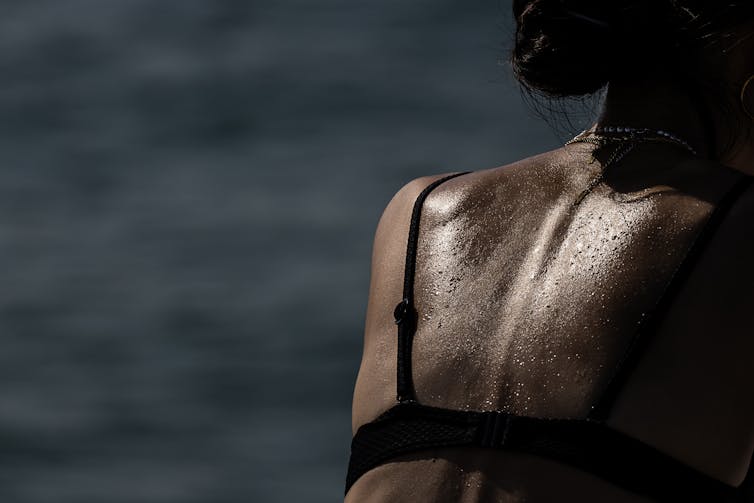 Some mammals are super hairy, some are not. Ed Jones/AFP via Getty Images –
Some mammals are super hairy, some are not. Ed Jones/AFP via Getty Images –
Curious Kids is a series for children of all ages. If you have a question you’d like an expert to answer, send it to CuriousKidsUS@TheConversation.Com.
Why don’t humans have hair all over their bodies like other animals? – Murilo, age 5, Brazil
Have you ever wondered why you don’t have thick hair covering your whole body like a dog, cat or gorilla does?Humans aren’t the only mammals with sparse hair. Elephants, rhinos and naked mole rats also have very little hair. It’s true for some marine mammals, such as whales and dolphins, too.
Scientists think the earliest mammals, which lived at the time of the dinosaurs, were quite hairy. But over hundreds of millions of years, a small handful of mammals, including humans, evolved to have less hair. What’s the advantage of not growing your own fur coat?
I’m a biologist who studies the genes that control hairiness in mammals. Why humans and a small number of other mammals are relatively hairless is an interesting question. It all comes down to whether certain genes are turned on or off.
Hair benefits
Hair and fur have many important jobs. They keep animals warm, protect their skin from the sun and injuries and help them blend into their surroundings.
They even assist animals in sensing their environment. Ever felt a tickle when something almost touches you? That’s your hair helping you detect things nearby.
Humans do have hair all over their bodies, but it is generally sparser and finer than that of our hairier relatives. A notable exception is the hair on our heads, which likely serves to protect the scalp from the sun. In human adults, the thicker hair that develops under the arms and between the legs likely reduces skin friction and aids in cooling by dispersing sweat.
So hair can be pretty beneficial. There must have been a strong evolutionary reason for people to lose so much of it.
Why humans lost their hair
The story begins about 7 million years ago, when humans and chimpanzees took different evolutionary paths. Although scientists can’t be sure why humans became less hairy, we have some strong theories that involve sweat.

–
Humans have far more sweat glands than chimps and other mammals do. Sweating keeps you cool. As sweat evaporates from your skin, heat energy is carried away from your body. This cooling system was likely crucial for early human ancestors, who lived in the hot African savanna.
Of course, there are plenty of mammals living in hot climates right now that are covered with fur. Early humans were able to hunt those kinds of animals by tiring them out over long chases in the heat – a strategy known as persistence hunting.
Humans didn’t need to be faster than the animals they hunted. They just needed to keep going until their prey got too hot and tired to flee. Being able to sweat a lot, without a thick coat of hair, made this endurance possible.
Genes that control hairiness
To better understand hairiness in mammals, my research team compared the genetic information of 62 different mammals, from humans to armadillos to dogs and squirrels. By lining up the DNA of all these different species, we were able to zero in on the genes linked to keeping or losing body hair.
Among the many discoveries we made, we learned humans still carry all the genes needed for a full coat of hair – they are just muted or switched off.
In the story of “Beauty and the Beast,” the Beast is covered in thick fur, which might seem like pure fantasy. But in real life some rare conditions can cause people to grow a lot of hair all over their bodies. This condition, called hypertrichosis, is very unusual and has been called “werewolf syndrome” because of how people who have it look.

–
In the 1500s, a Spanish man named Petrus Gonsalvus was born with hypertrichosis. As a child he was sent in an iron cage like an animal to Henry II of France as a gift. It wasn’t long before the king realized Petrus was like any other person and could be educated. In time, he married a lady, forming the inspiration for the “Beauty and the Beast” story.
While you will probably never meet someone with this rare trait, it shows how genes can lead to unique and surprising changes in hair growth.
Hello, curious kids! Do you have a question you’d like an expert to answer? Ask an adult to send your question to CuriousKidsUS@TheConversation.Com. Please tell us your name, age and the city where you live.
And since curiosity has no age limit – adults, let us know what you’re wondering, too. We won’t be able to answer every question, but we will do our best.
–
Helping you understand the news
When complicated stories are in the news, The Conversation is especially relevant. Our editors specialize in finding experts and helping them write articles explaining the key concepts clearly, but always accurately, based on years or decades of study.
The future of AI is a perfect example of this. There’s been a lot of facile analysis in the media from pundits who either position it as the greatest advancement of all time or posit horror stories about it running amok. But readers of The Conversation have benefitted from thoughtful analysis and research from dozens of experts, from disciplines ranging from information retrieval to ethics, law, education to art.
If you give today, we’ll send you two e-books. The first compiles seven of our most insightful articles on the future of work, ranging across topics from the impact of generative AI to how workers are taking more control over their work lives. The second brings together articles on the wisdom of ancient texts.
It’s our way of thanking the readers who make what we do possible, and it will enable us to continue toprovide this trustworthy journalism for free to readers around the world.
Thank you.
–
Want to write?
Write an article and join a growing community of more than 202,400 academics and researchers from 5,176 institutions.















Wrong Way Barry
logged in via Google
Boy did they miss it. All the other apes babies hold onto the hair of their mothers with all fours. So sexual selection cannot select less hairy females. Humans are the only ape that evolved feet that can’t grip. Baby’s hands are strong enough, human babies can be lifted by their grip. But losing the ability to grip with the feet means fur is obsolete. The mother must carry the baby. Now sexual selection can take over. Hominin males prefer less hairy females. Only in human apes can this preference be manifest. I feel that I must mention male provisioning. Of females. Upright walking means males compete by provisioning females. Proof is the shrinking of the canines. Male apes bite each other when fighting over females. Humans don’t. This is all one evolutionary change. It includes small teeth as humans hands select the tenderest foods. And males bring this food to females.
Robert Durkacz
For a suggestion, humans may have shed their hair when they learned to keep themselves warm and dry when necessary by building shelters, making fires and making clothes out of animal skins. Then this gave them the advantage of staying cool, sweating etc, when that was advantageous. So losing hair was beneficial to temperature tolerance. Whether this true or not I really don’t know, but it seems very reasonable if the timelines for losing hair and basic toolmaking line up.
–